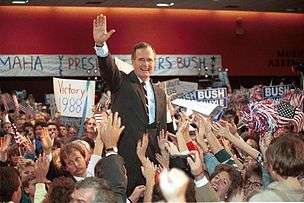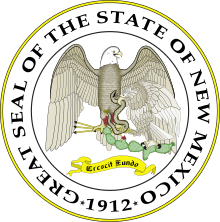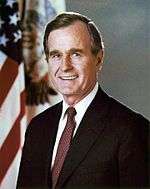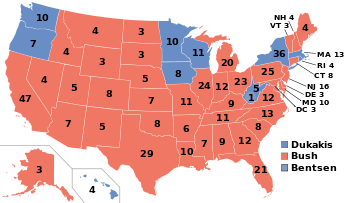United States presidential election in New Mexico, 1988
| | ||||||||||||||||||||||||||||||||
| ||||||||||||||||||||||||||||||||
| ||||||||||||||||||||||||||||||||
|
| ||||||||||||||||||||||||||||||||
| County Results
Dukakis—70-80%
Dukakis—60-70%
Dukakis—50-60%
Bush—<50%
Bush—50-60%
Bush—60-70% | ||||||||||||||||||||||||||||||||
| ||||||||||||||||||||||||||||||||
The 1988 United States presidential election in New Mexico took place on November 8, 1988. All 50 states and the District of Columbia, were part of the 1988 United States presidential election. New Mexico voters chose 5 electors to the Electoral College, which selected the President and Vice President.
New Mexico was won by incumbent United States Vice President George H. W. Bush of Texas, who was running against Massachusetts Governor Michael Dukakis. Bush ran with Indiana Senator Dan Quayle as Vice President, and Dukakis ran with Texas Senator Lloyd Bentsen.
New Mexico weighed in for this election as 2% more Democratic than the national average.
Partisan background

The presidential election of 1988 was a very partisan election for New Mexico, with 98% of the electorate voting for either the Democratic or Republican parties.[1] This is one of the last Presidential elections in New Mexico in which you see the highly populated counties of Bernalillo and Los Alamos turning out primarily Republican. The Democratic stronghold in the northern part of the state is evident during this election, and remains largely intact from this point onward to current political times.
Republican victory
Bush won the election in New Mexico with a solid 5 point margin. The election results in New Mexico are reflective of a nationwide reconsolidation of base for the Republican Party, which took place through the 1980s. Through the passage of some very controversial economic programs, spearheaded by then President Ronald Reagan (called, collectively, "Reaganomics"), the mid-to-late 1980's saw a period of economic growth and stability. The hallmark for Reaganomics was, in part, the wide-scale deregulation of corporate interests, and tax cuts for the wealthy.[2]
Dukakis ran on a socially liberal agenda, and advocated for economic reform and governmental transparency. Bush, on the other hand, ran on a campaign of continuing the social and economic policies of former President Reagan - which gained him much support with social conservatives and people living in rural areas, who largely associated the Republican Party with the economic growth of the 1980s. Additionally, while the economic programs passed under Reagan, and furthered under Bush and Clinton, may have boosted the economy for a brief period, they are criticized by many analysts as "setting the stage" for economic troubles in the United State after 2007, such as the Great Recession.[3]
| Elections in New Mexico |
|---|
 |
|
General elections |
|
|
|
|
Results
| United States presidential election in New Mexico, 1988 | |||||
|---|---|---|---|---|---|
| Party | Candidate | Votes | Percentage | Electoral votes | |
| Republican | George H. W. Bush | 270,341 | 51.86% | 5 | |
| Democratic | Michael Dukakis | 244,497 | 46.90% | 0 | |
| Libertarian | Ron Paul | 3,268 | 0.63% | 0 | |
| New Alliance Party | Lenora Fulani | 2,237 | 0.43% | 0 | |
| Socialist Workers Party | James Warren | 344 | 0.07% | 0 | |
| Workers World | Larry Holmes | 258 | 0.05% | 0 | |
| Prohibition | Earl Dodge | 249 | 0.05% | 0 | |
| Write-Ins | 93 | 0.02% | 0 | ||
| Totals | 521,287 | 100.0% | 5 | ||
See also
References
- ↑ "Dave Leip's Atlas of U.S. Presidential Elections". Uselectionatlas.org. Retrieved 2013-07-21.
- ↑ "Since 1980s, the Kindest of Tax Cuts for the Rich". The New York Times. 2012-01-18. Retrieved 2013-07-21.
- ↑ Jerry Lanson (2008-11-06). "A historic victory. A changed nation. Now, can Obama deliver?". Christian Science Monitor. Retrieved 2013-07-21.


.jpg)
